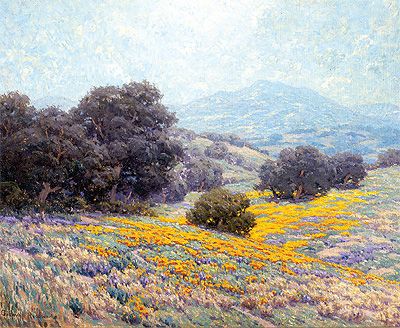 |
| Paul Hosemann, Camping Trip, Trinity County, CA |
Wednesday, July 29, 2020
Friday, July 24, 2020
She's (Almost) Baaack
Thursday, July 16, 2020
Distance Learning
 |
| Edward Hopper, Western Motel, 1957, oil on canvas |
So, today I've been thinking about the relationships between Richard Diebenkorn's and Edward Hopper's art. They aren't accidental.
When Richard Diebenkorn was learning to paint in the 1950's, Abstract Expressionism was the vogue. So much so that, in a determination to be 'with it,' the San Francisco Art Institute recruited several "AbEx's" from the East Coast and more or less banned realistic painting. The point of Ab Ex was to let the art 'flow from the artist's emotions and soul (or some mystical place) directly onto the canvas.'
Diebenkorn tried and actually succeeded but never resonated with this expressive method. His natural thinking process was orderly, methodical, architectural; he didn't wear his soul on his sleeve. So he turned to the study of other artists for his guidance - through books, magazines, and especially actual works if he could get his eyes on them.
His first main 'teacher' (although he wasn't aware of it) was Edward Hopper. Diebenkorn encountered Hopper's austere Americana at age 20 when he was in Stanford's art program. And he fell hard. In his own words: I embraced Hopper completely ...It was his use of light and shade and the atmosphere...kind of drenched, saturated with mood, and its kind of austerity. It was the kind of work that just seemed made for me. I looked at it and it was mine.
 |
| Richard Diebenkorn, Girl Looking at Landscape, 1957, oil on canvas |
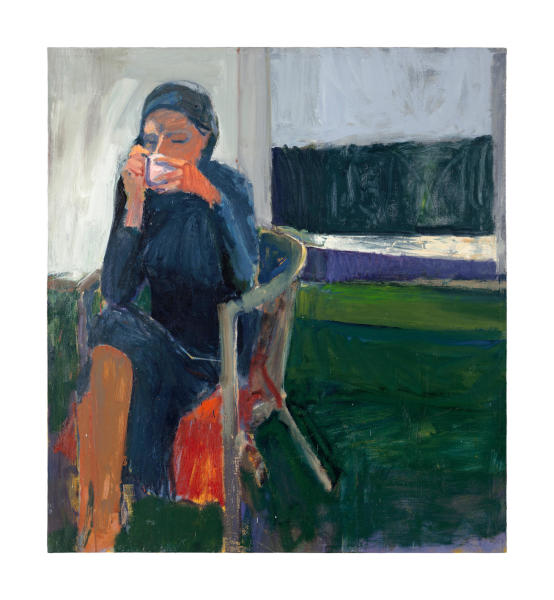 | ||
Richard Diebenkorn, Coffee, 1959, oil on canvas
|
 |
| Richard Diebenkorn in front of two of his Ocean Park paintings |
California Beauty Contest
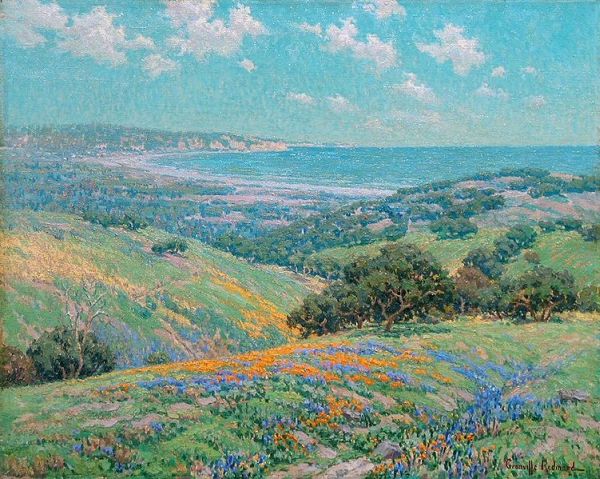 |
| Granville Redmond, Malibu Coast, Spring, @1910, oil on canvas |
| Richard Diebenkorn, Cityscape #1, 1963, 60 1/4x 50 1/2", oil on canvas |
Which painting do you prefer?
One of my favorite art critics recently wrote of the painting on the bottom "There may be no more beautiful painting of California than this 1963 work by Richard Diebenkorn."* And, Wow!, that is saying a lot.
Ciwt can certainly see the critic's point. Diebenkorn is one of my favorite artists, Cityscape #1 lives right here at SFMOMA and is a painting I knows well and like very much. But all time most beautiful?
My mind goes to Granville Redmond. His paintings would be exceptionally strong candidates for most beautiful Caifornia images.
Redmond was born in Philadelphia but relocated with his family to San Jose at a very young age. He was diagnosed as deaf at age three, but this hearing impairment did not stand in the way of his development and career as an artist. An early deaf instructor who gave young Redmond courses in painting, drawing and pantomime was extremely important in this development and Redmond eventually enrolled at the California School of Design in San Francisco where he excelled.
He was well liked and befriended by many of his peer artists, including Gottardo Piazzoni and later Charlie Chaplin, both of whom learned sign language in order to make communication with Redmond easier. Chaplin was such a champion of Redmond that he included him in several of his silent films as well as collecting and promoting his art.
Like Diebenkorn, Redmond eventually settled in Los Angeles with his wife, Carrie Ann Jean, also deaf, and their three children. Again like Diebenkorn, landscape and California were Redmond's true artistic loves (Cityscape #1 is essentially a landscape). But for Redmond it was impressionism and gorgeous poppy fields in broad valleys and gently rising California mountain peaks that called to him.
After and before Redmond's and Diebenkorn's there are the paintings by William Keith, Thomas Cole, even Hockney, Thiebaud... The list of talented artists, traditional and modern, who have fixed their eye and brush on California's vast and complex beauty goes on and on. So, for me, it follows there are many entrants to the Most Beautiful Painting of California Contest.
The Maine Thing
Certain American artists live in an exalted realm for me, their works so excellent and reviews so extensive that I shy away from saying anything about them. But today images of two of them, the writer E.B. White and the painterWinslow Homer, unexpectedly arrived in my email, and this has prompted her to dare a few words.
Probably I needn't worry about taking them down from their pedestals. Neither of these iconic artists likely gave a hoot whether they were on anyone's pedestal. Homer devoted numerous paintings to man's tiny, transient, fragile place within the timeless force of nature. And White wonderfully (as always) expressed his thoughts on individual grandeur: "In every queen there is a touch of floozy."
And I can safely say they both chose to live their last years in Maine. And both were originally 'from away,' meaning,for both, New York City - at least at the beginning of his career in Homer's case. Of Maine, White famously wrote “I would rather feel bad in Maine, than feel good anywhere else,” which goes far in capturing White's dry humor and Maine 'soul.'
It is anyone's guess what Winslow Homer (1836-1910) said about Maine - or anything personal for that matter. He craved solitude and was notoriously private, denying commentary even to his biographer. Prouts Neck, Maine offered him that privacy and silence and appears to be the place that brought out his truest genius. Already thought by many to be the greatest American artist of the nineteenth century, his paintings took on a new intensity when he moved there late in life. In Maine he began his deep concentration on the vast, rugged, violent power of the sea. And these emotional, virtuoso painterly responses to nature are the works - of all his magnificent output - that command the most respect today.
Winslow Homer, Northeaster, 1895, reworked 1901, 34 1/2 x 50", oil on canvas
|
Elwyn Brooks (E.B.) White (1899-1985)is the creator of Stuart Little, Charlotte's Web, The Elements of Style and This is New York among many other - often award winning - essays and books. To me much of his writing is so exquisite and touching I can nearly cry just thinking about it. So I'm just going to let him speak for himself today and refer you to the writings of his stepson and fellow New Yorker writer, Roger Angell, for biographical and anecdotal reading.
 |
| E.B. White typing |
“By comparison with other less hectic days, the city is uncomfortable and inconvenient; but New Yorkers temperamentally do not crave comfort and convenience- if they did they would live elsewhere.”
― E B White, Here Is New York
― E B White, Here Is New York
“A poem compresses much in a small space and adds music, thus heightening its meaning. The city is like poetry: it compresses all life, all races and breeds, into a small island and adds music and the accompaniment of internal engines. The island of Manhattan is without any doubt the greatest human concentrate on earth, the poem whose magic is comprehensible to millions of permanent residents but whose full meaning will always remain elusive.”
― E.B. White, Here Is New York
― E.B. White, Here Is New York
“A library is a good place to go when you feel unhappy, for there, in a book, you may find encouragement and comfort. A library is a good place to go when you feel bewildered or undecided, for there, in a book, you may have your question answered. Books are good company, in sad times and happy times, for books are people - people who have managed to stay alive by hiding between the covers of a book."
[Letters of Note; Troy (MI, USA) Public Library, 1971]”
[Letters of Note; Troy (MI, USA) Public Library, 1971]”
― E.B. White
“If the world were merely seductive, that would be easy. If it were merely challenging, that would be no problem. But I arise in the morning torn between a desire to improve (or save) the world and a desire to enjoy (or savor) the world. This makes it hard to plan the day.”
“Life’s meaning has always eluded me and I guess it always will. But I love it just the same.”
"All that I hope to say in books, all that I ever hope to say, is that I love the world." *To this I would like to add This is how I feel about LivingArt.
Legacy of Care Continues
 |
| Gustave Caillebotte, Portrait de Jean Daurelle, en pied. Donated to Musee d'Orsay, 2019 |
Gustave Caillebotte died of pulmonary congestion while working in his garden at Petit-Gennevilliers in 1894 at age 45. He is interred at Pere Lachaise Cemetery in Paris.
He had had no need for money or agents to promote his work and sold very few of his artworks during his lifetime. His motives behind these few sales are unknown. And the treasure trove of 68 masterpieces in the legacy he left to the French government did not include any by Caillebotte himself. Also, his remaining brother, Martial, retained the remaining artworks by Gustave in the family. So, it is understandable that Caillebotte became far better known after his death for his collection of paintings by his Impressionist friends than for his own work which was largely forgotten..
Then somewhere around 1950 his descendents began to offer some of his works for sale, and the art world took particular notice in 1964 when the Art Institute of Chicage acquired Paris Street, Rainy Day. Now the American art market woke up. By the 1970's his work had been reassessed and exhibited for the first time in nearly 80 years.
 |
| Paris Street, Rainy Day, 1877, ca 6.9' x 9' |
But even then, Gustave's descendents have been slow to let go of his art. Perhaps like him they have little need for the proceeds plus time is certainly on their side as his reputation continues to grow. Some relatives insist that the only reason the family let go of Paris Street, Rainly Day is that no one had the necessary wall space to display the enormous work.
To me there is a certain charm in hearing about what has become of Caillebotte's works over the years. There often seems to be a certain care about how his work is passed on; money doesn't seem to be the entire point. For instance, a major work (but not from his most marvelous, early period), Chemin Montant, fetched $22 million at auction at Christie's just over a year ago. An enormous amount of money yes, but it was sold specifically 'to benefit a charitable foundation."
And, again very recently, five little-known works which belonged to Caillebotte's butler, Jean Daurelle, were put on view at the Musee d'Orsay. They were a remarkable gift made by Daurelle's great granddaugher. The works had been passed down to her through her family and could have been sold for large sums. But she refused all offers by hopeful buyers and donated them to the Musee which was thrilled and touched.
This gesture was right up Gustave's donating alley, and some part of me likes to think he would have been pleased and proud.
.jpg) |
| Gustave Caillebotte, Chemin Montant, 1881, oil on canvas Sold at auction to benefit a charitable foundation, 27 February 2019. Fetched $22,000,000 |
Much More Than a Patron
 |
| Gustave Caillebotte (1848-1894) |
So today I'm wondering wondering where the whole Impressionist and post-Impressionist movements would be without Gustave Caillebotte.
Because the submissions of many of the group of artists who came to be associated with Impressionism were routinely rejected by the Academie's all important annual Salon de Paris they began to organize their own exhibitions. The first of these, the Salon des Refuses in 1863, was sponsored by Napoleon III, but when the artists petitioned to have another of these salons they were rejected again and again. So, in 1873, in frustration and desperation, several of them founded a Society to exhibit their artworks independently.
But establishing a formal name and intention was quite a different matter from financing their exhibitions and realizing money on sales. Their names included Monet, Renoir, Sisley and others, and most of them were living on the edge of poverty. It is not impossible to assume that many of them - hence the Impressionist movement - might have failed if it had not been for Caillebotte who funded several of their exhibitions and, now famously, purchased many of their works which form the cornerstone of the Musee d'Orsay collection of masterpieces from that period.
Probably because he had inherited a fortune at age 26 and never had to live off his art sales, Caillebotte, arguably one of the most important Impressionists, was the least well known until relatively recently. (More on making a name in art in another CIWT). As his name is coming to the fore, a charismatic, energetic, multi-talented man is being revealed.
For one thing, he was a serious, dedicated artist who painted several of the world's most important masterpieces. Perhaps you've seen posters or been to the d'Orsay and viewed the actual and magnificent The Floor Scrapers.
And, if you've been to the Chicago Institute of Art, you've certainly seen its other (besides George Seurat's La Grande Jatte) most popular Impressionist painting:
 |
| Paris Street, Rainy Day, 1877, ca 6.9' x 9' |
In addition to being a licensed (but never practicing) lawyer, dedicated art patron, collector, and passionate painter, Caillebotte used his wealth to fund a variety of hobbies for which he was equally passionate. These included stamp collecting (his collection is now in the British Museum), orchid horticulture, yacht building (he was a studied naval engineer), even textile design. As if that isn't enough, Caillebotte's garden at his Petit Gennevilliers estate on the Seine was a strong influence on Monet's famous garden. Caillebotten would sail downstream to Giverny and the two artist-gardeners would enjoy innumerable hours sharing thoughts on their mutual loves.
No d'Orsay?
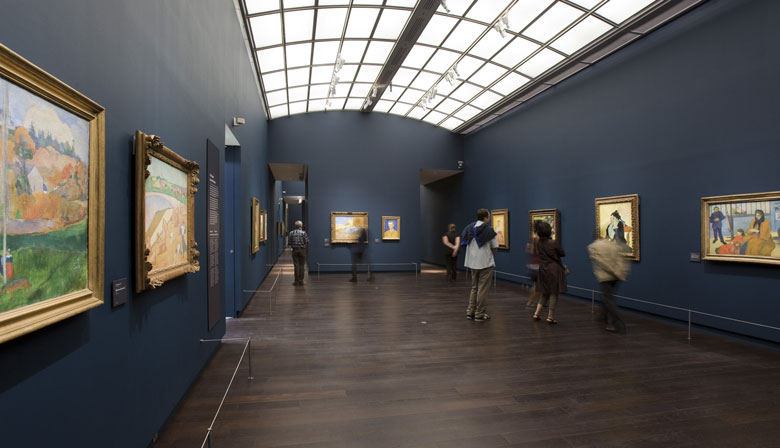 |
| One of many Impressionist and post-Impressionist galleries at the Musee d'Orsay |
This incredible bequest was accepted only relunctantly by the State. In fact they refused the paintings at first. Why? Well, the 68(!) paintings in his collection were by Caillebotte's friends and acquaintances whom he liked, admired and patronized. Their names included Monet (they were gardening buddies), Manet, Renoir, Degas, Cezanne, Seurat, the list goes on. Virtually all either Impressionists or Post-Impressionists which was France's problem with the collection. In 1894, at the time of Caillebotte's early death at age 45 and will, those two art forms were still considered minor, possibly a passing fad, by the powers that be in the French art world. The French state was actually quite embarrassed by the gift and reluctant to devote valuable museum exhibition space to it.
Finally, three years later, they accepted the bequest. By that time, they had culled through it, and deemed only 40 acceptable. (The rest were refused and either retained or sold by the family). Finally the Caillebotte Room at the Luxembourg Palace opened to the public in 1897, the first exhibition of Impressionist paintings ever to be displayed in a French Museum.
The rest of course is history. Much to the dismay of the French government who made an attempt to reclaim the other 28 works in 1928. The government was rebutted by Caillebotte's heirs and the works remain in private - or non-Musee d'Orsay museum - collections to this day. The original paintings from Caillebotte's legacy form the core of the Musee d'Orsay's renowned Impressionist collection. Heureusement! (ie, Luckily)
What Work Looks Like
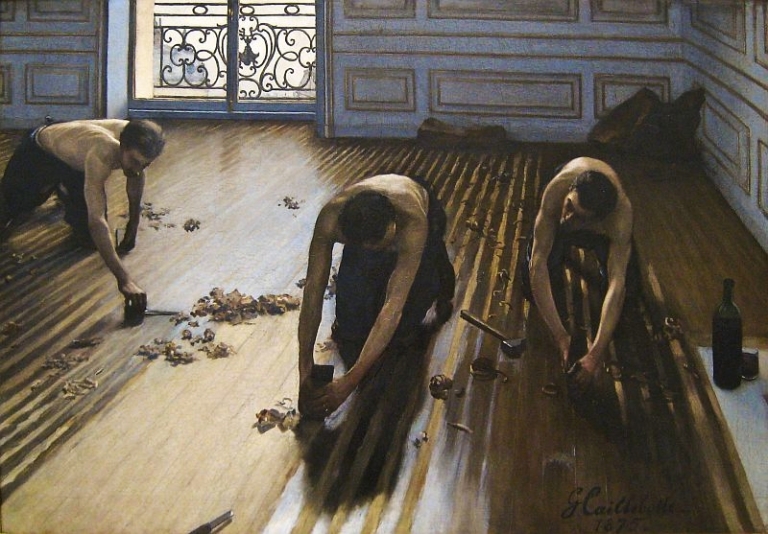 |
| Gustave Caillebotte, The Floor Scrapers, 1875, 6'4" x 4'9" |
Well, I didn't work quite this hard cleaning her place today. But it felt this way at times because I don't have my housework skills down.
Viewing the famous and greatly respected The Floor Scrapers, it is easy to see how Caillebotte gained his reputation as one of the great realist artists of the 19th century.
The Floor Scrapers is known for its early depiction of the urban working class at work. Until this painting, nearly all pictures of men and women at work were country scenes of farm workers and peasants (often idealized or standing for a particular political message). Caillebotte has no such message about his subjects here, or, if he does, he avoids the temptation to contain it in his painting. Instead he paints masterfully in a neutral, nearly documentary style focusing on the workers' actions, tools, muscular bodies and the soft lighting. Perhaps his neutrality is one of the reasons the The Floor Scrapers continues to be beloved and respected by viewers at all levels of society.
More to come on Monsieur Gustave Caillebotte....
Subscribe to:
Posts (Atom)


